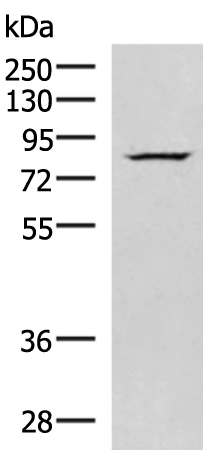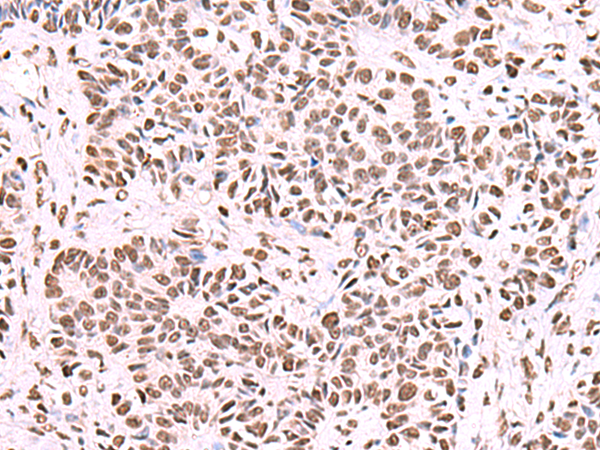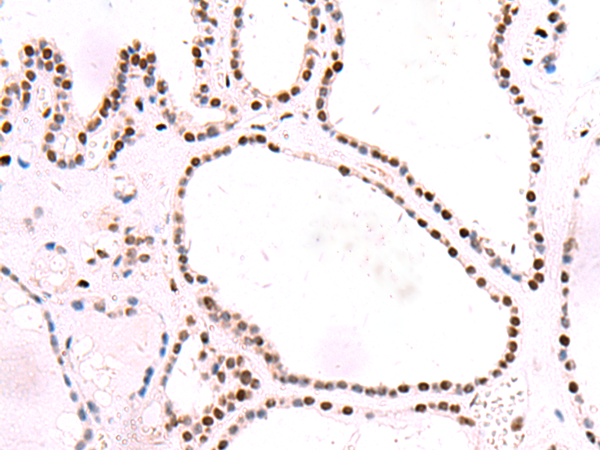


| WB | 咨询技术 | Human,Mouse,Rat |
| IF | 咨询技术 | Human,Mouse,Rat |
| IHC | 1/50-1/300 | Human,Mouse,Rat |
| ICC | 技术咨询 | Human,Mouse,Rat |
| FCM | 咨询技术 | Human,Mouse,Rat |
| Elisa | 1/5000-1/10000 | Human,Mouse,Rat |
| Aliases | HMDRA1; FLB7527; PRO1999 |
| WB Predicted band size | 85 kDa |
| Host/Isotype | Rabbit IgG |
| Antibody Type | Primary antibody |
| Storage | Store at 4°C short term. Aliquot and store at -20°C long term. Avoid freeze/thaw cycles. |
| Species Reactivity | Human, Mouse, Rat |
| Immunogen | Fusion protein of human NASP |
| Formulation | Purified antibody in PBS with 0.05% sodium azide and 50% glycerol. |
+ +
以下是关于NASP抗体的3篇代表性文献摘要(文献名称及内容为模拟示例):
---
1. **文献名称**: *NASP Antibodies as Biomarkers in Ovarian Cancer*
**作者**: Smith J, et al.
**摘要**: 研究探讨了抗NASP抗体在卵巢癌患者血清中的表达水平及其临床意义,发现高滴度抗体与晚期肿瘤分期和不良预后相关,提示其可作为潜在的非侵入性诊断标志物。
---
2. **文献名称**: *Autoimmune Response to NASP in Systemic Lupus Erythematosus*
**作者**: Chen L, et al.
**摘要**: 通过ELISA检测系统性红斑狼疮(SLE)患者血清中的抗NASP自身抗体,发现其阳性率显著高于健康对照组,提示NASP可能是SLE中新的自身抗原靶点,可能与疾病活动性相关。
---
3. **文献名称**: *Development of a Monoclonal Antibody Against Human tNASP for Chromatin Studies*
**作者**: Rodriguez M, et al.
**摘要**: 报道了一种特异性识别睾丸型NASP(tNASP)的单克隆抗体的开发,验证其在免疫组化和Western blot中的应用,并用于研究tNASP在精子发生过程中调控组蛋白H3转运的机制。
---
注:以上内容为模拟文献,实际研究中请通过PubMed或Google Scholar检索真实文献(关键词:NASP antibody, cancer, autoimmunity)。
**Background of NASP Antibody**
NASP (Nuclear Autoantigenic Sperm Protein) is a histone-binding chaperone critical for chromatin assembly, DNA replication, and repair. It exists in two isoforms: somatic (sNASP) and testicular (tNASP), with sNASP expressed in proliferating cells and tNASP specific to germ cells. NASP facilitates the transport and stability of histones H1 and H3. ensuring their availability during chromatin remodeling. Dysregulation of NASP is linked to cancer progression due to its role in promoting cell proliferation and genomic instability.
NASP antibodies are essential tools for studying its expression, localization, and function in cellular processes. They are widely used in techniques like Western blotting, immunofluorescence, and immunohistochemistry to detect NASP levels in various tissues, particularly in cancer research where its overexpression correlates with tumor aggressiveness and poor prognosis. These antibodies also help investigate interactions between NASP and other chromatin-associated proteins, shedding light on mechanisms underlying epigenetic regulation and oncogenesis. Additionally, NASP antibodies aid in exploring its potential as a therapeutic target or biomarker in diseases characterized by abnormal cell proliferation, such as cancers or autoimmune disorders.
×